This article is about irrigation in agriculture. For other uses, see Irrigation (disambiguation).
Irrigation is the method in which a controlled amount of water is supplied to plants at regular intervals for agriculture. It is used to assist in the growing of agricultural crops, maintenance of landscapes, andrevegetation of disturbed soils in dry areas and during periods of inadequate rainfall. Additionally, irrigation also has a few other uses in crop production, which include protecting plants against frost,[1]suppressing weed growth in grain fields[2] and preventing soil consolidation.[3] In contrast, agriculturethat relies only on direct rainfall is referred to as rain-fed or dry land farming.
Irrigation systems are also used for dust suppression, disposal of sewage, and inmining. Irrigation is often studied together with drainage, which is the natural or artificial removal of surface and sub-surface water from a given area.
Irrigation has been a central feature of agriculture for over 5,000 years and is the product of many cultures. Historically, it was the basis for economies and societies across the globe, from Asia to the Southwestern United States.
History
Archaeological investigation has found evidence of irrigation where the naturalrainfall was insufficient to support crops for rainfed agriculture.
Perennial irrigation was practiced in theMesopotamian plain whereby crops were regularly watered throughout thegrowing season by coaxing water through a matrix of small channels formed in the field.[4]
Ancient Egyptians practiced Basin irrigation using the flooding of the Nileto inundate land plots which had been surrounded by dykes. The flood water was held until the fertile sediment had settled before the surplus was returned to the watercourse.[5] There is evidence of the ancient Egyptian pharaohAmenemhet III in the twelfth dynasty(about 1800 BCE) using the natural lake of the Faiyum Oasis as a reservoir to store surpluses of water for use during the dry seasons, the lake swelled annually from flooding of the Nile.[6]
The Ancient Nubians developed a form of irrigation by using a waterwheel-like device called a sakia. Irrigation began in Nubia some time between the third and second millennium BCE.[7] It largely depended upon the flood waters that would flow through the Nile River and other rivers in what is now the Sudan.[8]
In sub-Saharan Africa irrigation reached the Niger River region cultures and civilizations by the first or second millennium BCE and was based on wet season flooding and water harvesting.[9][10]
Terrace irrigation is evidenced in pre-Columbian America, early Syria, India, and China.[5] In the Zana Valley of theAndes Mountains in Peru, archaeologists found remains of three irrigation canals radiocarbon dated from the 4th millennium BCE, the 3rd millennium BCE and the 9th century CE. These canals are the earliest record of irrigation in the New World. Traces of a canal possibly dating from the 5th millennium BCE were found under the 4th millennium canal.[11] Sophisticated irrigation and storage systems were developed by the Indus Valley Civilization in present-day Pakistan andNorth India, including the reservoirs atGirnar in 3000 BCE and an early canal irrigation system from circa 2600 BCE.[12][13] Large scale agriculture was practiced and an extensive network of canals was used for the purpose of irrigation.
Ancient Persia (modern day Iran) as far back as the 6th millennium BCE, where barley was grown in areas where the natural rainfall was insufficient to support such a crop.[14] The Qanats, developed in ancient Persia in about 800 BCE, are among the oldest known irrigation methods still in use today. They are now found in Asia, the Middle East and North Africa. The system comprises a network of vertical wells and gently sloping tunnels driven into the sides of cliffs and steep hills to tap groundwater.[15] The noria, a water wheel with clay pots around the rim powered by the flow of the stream (or by animals where the water source was still), was first brought into use at about this time, by Roman settlers in North Africa. By 150 BCE the pots were fitted with valves to allow smoother filling as they were forced into the water.[16]
The irrigation works of ancient Sri Lanka, the earliest dating from about 300 BCE, in the reign of KingPandukabhaya and under continuous development for the next thousand years, were one of the most complex irrigation systems of the ancient world. In addition to underground canals, theSinhalese were the first to build completely artificial reservoirs to store water. Due to their engineering superiority in this sector, they were often called 'masters of irrigation'.[by whom?]Most of these irrigation systems still exist undamaged up to now, inAnuradhapura and Polonnaruwa, because of the advanced and precise engineering. The system was extensively restored and further extended during the reign of KingParakrama Bahu (1153–1186 CE).[17]
China
The oldest known hydraulic engineers ofChina were Sunshu Ao (6th century BCE) of the Spring and Autumn period andXimen Bao (5th century BCE) of theWarring States period, both of whom worked on large irrigation projects. In the Sichuan region belonging to theState of Qin of ancient China, theDujiangyan Irrigation System was built in 256 BCE to irrigate an enormous area of farmland that today still supplies water.[18] By the 2nd century AD, during the Han Dynasty, the Chinese also usedchain pumps that lifted water from lower elevation to higher elevation.[19]These were powered by manual foot pedal, hydraulic waterwheels, or rotating mechanical wheels pulled by oxen.[20]The water was used for public works of providing water for urban residential quarters and palace gardens, but mostly for irrigation of farmland canals and channels in the fields.[21]
Korea
In 15th century Korea, the world's first rain gauge, uryanggye (Korean:우량계), was invented in 1441. The inventor wasJang Yeong-sil, a Korean engineer of theJoseon Dynasty, under the active direction of the king, Sejong the Great. It was installed in irrigation tanks as part of a nationwide system to measure and collect rainfall for agricultural applications. With this instrument, planners and farmers could make better use of the information gathered in the survey.[22]
North America
Main article: Hohokam
In North America, the Hohokam were the only culture known to rely on irrigation canals to water their crops, and their irrigation systems supported the largest population in the Southwest by AD 1300. The Hohokam constructed an assortment of simple canals combined with weirs in their various agricultural pursuits. Between the 7th and 14th centuries, they also built and maintained extensive irrigation networks along the lower Salt and middle Gila rivers that rivaled the complexity of those used in the ancient Near East, Egypt, and China. These were constructed using relatively simple excavation tools, without the benefit of advanced engineering technologies, and achieved drops of a few feet per mile, balancing erosion and siltation. The Hohokam cultivated varieties of cotton, tobacco, maize, beans and squash, as well as harvested an assortment of wild plants. Late in the Hohokam Chronological Sequence, they also used extensive dry-farming systems, primarily to grow agave for food and fiber. Their reliance on agricultural strategies based on canal irrigation, vital in their less than hospitable desert environment and arid climate, provided the basis for the aggregation of rural populations into stable urban centers.[23]
Present extent
In the mid-20th century, the advent of diesel and electric motors led to systems that could pump groundwaterout of major aquifers faster thandrainage basins could refill them. This can lead to permanent loss of aquifer capacity, decreased water quality, ground subsidence, and other problems. The future of food production in such areas as the North China Plain, thePunjab, and the Great Plains of the US is threatened by this phenomenon.[24][25]
At the global scale, 2,788,000 km² (689 million acres) of fertile land was equipped with irrigation infrastructure around the year 2000. About 68% of the area equipped for irrigation is located in Asia, 17% in the America, 9% in Europe, 5% in Africa and 1% in Oceania. The largest contiguous areas of high irrigation density are found:
- In Northern India and Pakistan along the Ganges and Indus rivers
- In the Hai He, Huang He and Yangtze basins in China
- Along the Nile river in Egypt and Sudan
- In the Mississippi-Missouri river basin and in parts of California
Smaller irrigation areas are spread across almost all populated parts of the world.[26]
Only eight years later in 2008, the scale of irrigated land increased to an estimated total of 3,245,566 km² (802 million acres), which is nearly the size of India.[27]
Types of irrigation
Various types of irrigation techniques differ in how the water obtained from the source is distributed within the field. In general, the goal is to supply the entire field uniformly with water, so that each plant has the amount of water it needs, neither too much nor too little.
Surface irrigation
Main article: Surface irrigation
In surface (furrow, flood, or level basin) irrigation systems, water moves across the surface of agricultural lands, in order to wet it and infiltrate into the soil. Surface irrigation can be subdivided into furrow, borderstrip or basin irrigation. It is often called flood irrigation when the irrigation results in flooding or near flooding of the cultivated land. Historically, this has been the most common method of irrigating agricultural land and still used in most parts of the world.
Where water levels from the irrigation source permit, the levels are controlled by dikes, usually plugged by soil. This is often seen in terraced rice fields (rice paddies), where the method is used to flood or control the level of water in each distinct field. In some cases, the water is pumped, or lifted by human or animal power to the level of the land. The field water efficiency of surface irrigation is typically lower than other forms of irrigation but has the potential for efficiencies in the range of 70% - 90% under appropriate management.
Localized irrigation
Localized irrigation is a system where water is distributed under low pressure through a piped network, in a pre-determined pattern, and applied as a small discharge to each plant or adjacent to it. Drip irrigation, spray or micro-sprinkler irrigation and bubbler irrigation belong to this category of irrigation methods.[28]
Subsurface textile irrigation
Main article: Subsurface textile irrigation
Subsurface Textile Irrigation (SSTI) is a technology designed specifically for subsurface irrigation in all soil textures from desert sands to heavy clays. A typical subsurface textile irrigation system has an impermeable base layer (usually polyethylene or polypropylene), a drip line running along that base, a layer of geotextile on top of the drip line and, finally, a narrow impermeable layer on top of the geotextile (see diagram). Unlike standard drip irrigation, the spacing of emitters in the drip pipe is not critical as the geotextile moves the water along the fabric up to 2 m from the dripper.
Drip irrigation
Main article: Drip irrigation
Drip (or micro) irrigation, also known as trickle irrigation, functions as its name suggests. In this system water falls drop by drop just at the position of roots. Water is delivered at or near the rootzone of plants, drop by drop. This method can be the most water-efficient method of irrigation,[29] if managed properly, since evaporation and runoff are minimized. The field water efficiency of drip irrigation is typically in the range of 80 to 90 percent when managed correctly.
In modern agriculture, drip irrigation is often combined with plastic mulch, further reducing evaporation, and is also the means of delivery of fertilizer. The process is known as fertigation.
Deep percolation, where water moves below the root zone, can occur if a drip system is operated for too long or if the delivery rate is too high. Drip irrigation methods range from very high-tech and computerized to low-tech and labor-intensive. Lower water pressures are usually needed than for most other types of systems, with the exception of low energy center pivot systems and surface irrigation systems, and the system can be designed for uniformity throughout a field or for precise water delivery to individual plants in a landscape containing a mix of plant species. Although it is difficult to regulate pressure on steep slopes, pressure compensating emitters are available, so the field does not have to be level. High-tech solutions involve precisely calibrated emitters located along lines of tubing that extend from a computerized set of valves.
Irrigation using sprinkler systems
Further information: Irrigation sprinkler
In sprinkler or overhead irrigation, water is piped to one or more central locations within the field and distributed by overhead high-pressure sprinklers or guns. A system utilizing sprinklers, sprays, or guns mounted overhead on permanently installed risers is often referred to as a solid-set irrigation system. Higher pressure sprinklers that rotate are called rotors an are driven by a ball drive, gear drive, or impact mechanism. Rotors can be designed to rotate in a full or partial circle. Guns are similar to rotors, except that they generally operate at very high pressures of 40 to 130 lbf/in² (275 to 900 kPa) and flows of 50 to 1200 US gal/min (3 to 76 L/s), usually with nozzle diameters in the range of 0.5 to 1.9 inches (10 to 50 mm). Guns are used not only for irrigation, but also for industrial applications such as dust suppression and logging.
Sprinklers can also be mounted on moving platforms connected to the water source by a hose. Automatically moving wheeled systems known astraveling sprinklers may irrigate areas such as small farms, sports fields, parks, pastures, and cemeteries unattended. Most of these utilize a length of polyethylene tubing wound on a steel drum. As the tubing is wound on the drum powered by the irrigation water or a small gas engine, the sprinkler is pulled across the field. When the sprinkler arrives back at the reel the system shuts off. This type of system is known to most people as a "waterreel" traveling irrigation sprinkler and they are used extensively for dust suppression, irrigation, and land application of waste water.
Other travelers use a flat rubber hose that is dragged along behind while the sprinkler platform is pulled by a cable. These cable-type travelers are definitely old technology and their use is limited in today's modern irrigation projects.
Irrigation using Center pivot
Main article: Center pivot irrigation
Center pivot irrigation is a form of sprinkler irrigation consisting of several segments of pipe (usually galvanized steel or aluminium) joined together and supported by trusses, mounted on wheeled towers with sprinklers positioned along its length.[30] The system moves in a circular pattern and is fed with water from the pivot point at the center of the arc. These systems are found and used in all parts of the world and allow irrigation of all types of terrain. Newer systems have drop sprinkler heads as shown in the image that follows.
Most center pivot systems now have drops hanging from a u-shaped pipe attached at the top of the pipe with sprinkler head that are positioned a few feet (at most) above the crop, thus limiting evaporative losses. Drops can also be used with drag hoses or bubblers that deposit the water directly on the ground between crops. Crops are often planted in a circle to conform to the center pivot. This type of system is known as LEPA (Low Energy Precision Application). Originally, most center pivots were water powered. These were replaced by hydraulic systems (T-L Irrigation) and electric motor driven systems (Reinke, Valley, Zimmatic). Many modern pivots feature GPSdevices.[citation needed]
Irrigation by Lateral move (side roll, wheel line, wheelmove)[31][32]
A series of pipes, each with a wheel of about 1.5 m diameter permanently affixed to its midpoint, and sprinklers along its length, are coupled together. Water is supplied at one end using a large hose. After sufficient irrigation has been applied to one strip of the field, the hose is removed, the water drained from the system, and the assembly rolled either by hand or with a purpose-built mechanism, so that the sprinklers are moved to a different position across the field. The hose is reconnected. The process is repeated in a pattern until the whole field has been irrigated.
This system is less expensive to install than a center pivot, but much more labor-intensive to operate - it does not travel automatically across the field: it applies water in a stationary strip, must be drained, and then rolled to a new strip. Most systems use 4 or 5-inch (130 mm) diameter aluminum pipe. The pipe doubles both as water transport and as an axle for rotating all the wheels. A drive system (often found near the centre of the wheel line) rotates the clamped-together pipe sections as a single axle, rolling the whole wheel line. Manual adjustment of individual wheel positions may be necessary if the system becomes misaligned.
Wheel line systems are limited in the amount of water they can carry, and limited in the height of crops that can be irrigated. One useful feature of a lateral move system is that it consists of sections that can be easily disconnected, adapting to field shape as the line is moved. They are most often used for small, rectilinear, or oddly-shaped fields, hilly or mountainous regions, or in regions where labor is inexpensive.
Sub-irrigation
Subirrigation has been used for many years in field crops in areas with highwater tables. It is a method of artificially raising the water table to allow the soilto be moistened from below the plants'root zone. Often those systems are located on permanent grasslands in lowlands or river valleys and combined with drainage infrastructure. A system of pumping stations, canals, weirs and gates allows it to increase or decrease the water level in a network of ditches and thereby control the water table.
Sub-irrigation is also used incommercial greenhouse production, usually for potted plants. Water is delivered from below, absorbed upwards, and the excess collected for recycling. Typically, a solution of water and nutrients floods a container or flows through a trough for a short period of time, 10–20 minutes, and is then pumped back into a holding tank for reuse. Sub-irrigation in greenhouses requires fairly sophisticated, expensive equipment and management. Advantages are water and nutrient conservation, and labor-saving through lowered system maintenance andautomation. It is similar in principle and action to subsurface basin irrigation.
Irrigation Automatically, non-electric using buckets and ropes
Besides the common manual watering by bucket, an automated, natural version of this also exists. Using plain polyester ropes combined with a prepared ground mixture can be used to water plants from a vessel filled with water.[33][34][35]
The ground mixture would need to be made depending on the plant itself, yet would mostly consist of black potting soil, vermiculite and perlite. This system would (with certain crops) allow to save expenses as it does not consume any electricity and only little water (unlike sprinklers, water timers, etc.). However, it may only be used with certain crops (probably mostly larger crops that do not need a humid environment; perhaps e.g. paprikas).[citation needed]
Irrigation using water condensed from humid air
In countries where at night, humid air sweeps the countryside.Water can be obtained from the humid air bycondensation onto cold surfaces. This is for example practiced in the vineyards atLanzarote using stones to condense water or with various fog collectorsbased on canvas or foil sheets.
In-ground irrigation
Most commercial and residential irrigation systems are "in ground" systems, which means that everything isburied in the ground. With the pipes,sprinklers, emitters (drippers), and irrigation valves being hidden, it makes for a cleaner, more presentable landscape without garden hoses or other items having to be moved around manually. This does, however, create some drawbacks in the maintenance of a completely buried system.
Most irrigation systems are divided into zones. A zone is a single irrigation valve and one or a group of drippers or sprinklers that are connected by pipes or tubes. Irrigation systems are divided into zones because there is usually not enough pressure and available flow to run sprinklers for an entire yard or sports field at once. Each zone has asolenoid valve on it that is controlled via wire by an irrigation controller. Theirrigation controller is either a mechanical (now the "dinosaur" type) or electrical device that signals a zone to turn on at a specific time and keeps it on for a specified amount of time. "Smart Controller" is a recent term for a controller that is capable of adjusting the watering time by itself in response to current environmental conditions. The smart controller determines current conditions by means of historic weather data for the local area, a soil moisture sensor (water potential or water content), rain sensor, or in more sophisticated systems satellite feed weather station, or a combination of these.
When a zone comes on, the water flows through the lateral lines and ultimately ends up at the irrigation emitter (drip) orsprinkler heads. Many sprinklers have pipe thread inlets on the bottom of them which allows a fitting and the pipe to be attached to them. The sprinklers are usually installed with the top of the head flush with the ground surface. When the water is pressurized, the head will pop up out of the ground and water the desired area until the valve closes and shuts off that zone. Once there is no more water pressure in the lateral line, the sprinkler head will retract back into the ground. Emitters are generally laid on the soil surface or buried a few inches to reduce evaporation losses.
Water sources

Irrigation is underway by pump-enabledextraction directly from the Gumti, seen in the background, in Comilla, Bangladesh.
Irrigation water can come from groundwater (extracted from springs or by using wells), from surface water (withdrawn from rivers, lakes orreservoirs) or from non-conventional sources like treated wastewater,desalinated water or drainage water. A special form of irrigation using surface water is spate irrigation, also calledfloodwater harvesting. In case of a flood (spate), water is diverted to normally dry river beds (wadis) using a network of dams, gates and channels and spread over large areas. The moisture stored in the soil will be used thereafter to grow crops. Spate irrigation areas are in particular located in semi-arid or arid, mountainous regions. While floodwater harvesting belongs to the accepted irrigation methods, rainwater harvestingis usually not considered as a form of irrigation. Rainwater harvesting is the collection of runoff water from roofs or unused land and the concentration of this.
Around 90% of wastewater produced globally remains untreated, causing widespread water pollution, especially in low-income countries. Increasingly, agriculture uses untreated wastewater as a source of irrigation water. Cities provide lucrative markets for fresh produce, so are attractive to farmers. However, because agriculture has to compete for increasingly scarce water resources with industry and municipal users (see Water scarcity below), there is often no alternative for farmers but to use water polluted with urban waste, including sewage, directly to water their crops. Significant health hazards can result from using water loaded with pathogens in this way, especially if people eat raw vegetables that have been irrigated with the polluted water. The International Water Management Institute has worked in India, Pakistan, Vietnam, Ghana, Ethiopia, Mexico and other countries on various projects aimed at assessing and reducing risks of wastewater irrigation. They advocate a 'multiple-barrier' approach to wastewater use, where farmers are encouraged to adopt various risk-reducing behaviours. These include ceasing irrigation a few days before harvesting to allow pathogens to die off in the sunlight, applying water carefully so it does not contaminate leaves likely to be eaten raw, cleaning vegetables with disinfectant or allowing fecal sludge used in farming to dry before being used as a human manure.[36] TheWorld Health Organization has developed guidelines for safe water use.
There are numerous benefits of using recycled water for irrigation, including the low cost (when compared to other sources, particularly in an urban area), consistency of supply (regardless of season, climatic conditions and associated water restrictions), and general consistency of quality. Irrigation of recycled wastewater is also considered as a means for plant fertilization and particularly nutrient supplementation. This approach carries with it a risk of soil and water pollution through excessive wastewater application. Hence, a detailed understanding of soil water conditions is essential for effective utilization of wastewater for irrigation.[37]
Efficiency

Young engineers restoring and developing the old Mughal irrigation system during the reign of the Mughal Emperor Bahadur Shah II
Modern irrigation methods are efficient enough to supply the entire field uniformly with water, so that each plant has the amount of water it needs, neither too much nor too little.[38] Water use efficiency in the field can be determined as follows:
- Field Water Efficiency (%) = (Water Transpired by Crop ÷ Water Applied to Field) x 100
Until 1960s, the common perception was that water was an infinite resource. At that time, there were fewer than half the current number of people on the planet. People were not as wealthy as today, consumed fewer calories and ate less meat, so less water was needed to produce their food. They required a third of the volume of water we presently take from rivers. Today, the competition for water resources is much more intense. This is because there are now more than seven billion people on the planet, their consumption of water-thirsty meat and vegetables is rising, and there is increasing competition for water fromindustry, urbanisation and biofuel crops. To avoid a global water crisis, farmers will have to strive to increase productivity to meet growing demands for food, while industry and cities find ways to use water more efficiently.[39]
Successful agriculture is dependent upon farmers having sufficient access to water. However, water scarcity is already a critical constraint to farming in many parts of the world. With regards to agriculture, the World Bank targets food production and water management as an increasingly global issue that is fostering a growing debate.[40] Physical water scarcity is where there is not enough water to meet all demands, including that needed for ecosystems to function effectively. Arid regions frequently suffer from physical water scarcity. It also occurs where water seems abundant but where resources are over-committed. This can happen where there is overdevelopment of hydraulic infrastructure, usually for irrigation. Symptoms of physical water scarcity include environmental degradation and declining groundwater. Economic scarcity, meanwhile, is caused by a lack of investment in water or insufficient human capacity to satisfy the demand for water. Symptoms ofeconomic water scarcity include a lack of infrastructure, with people often having to fetch water from rivers for domestic and agricultural uses. Some 2.8 billion people currently live in water-scarce areas.[41]
Technical challenges
Main article: Environmental impact of irrigation
Irrigation schemes involve solving numerous engineering and economic problems while minimizing negative environmental impact.[42]
- Competition for surface water rights.[43]
- Overdrafting (depletion) of underground aquifers.
- Ground subsidence (e.g. New Orleans, Louisiana)
- Underirrigation or irrigation giving only just enough water for the plant (e.g. in drip line irrigation) gives poor soil salinity control which leads to increasedsoil salinity with consequent buildup of toxic salts on soil surface in areas with high evaporation. This requires eitherleaching to remove these salts and a method of drainage to carry the salts away. When using drip lines, the leaching is best done regularly at certain intervals (with only a slight excess of water), so that the salt is flushed back under the plant's roots.[44][45]
- Overirrigation because of poordistribution uniformity or managementwastes water, chemicals, and may lead to water pollution.[46]
- Deep drainage (from over-irrigation) may result in rising water tables which in some instances will lead to problems of irrigation salinity requiring watertable control by some form of subsurface land drainage.[47][48]
- Irrigation with saline or high-sodiumwater may damage soil structure owing to the formation of alkaline soil
- Clogging of filters: It is mostly algae that clog filters, drip installations and nozzles. UV[49] and ultrasonic[50] method can be used for algae control in irrigation systems.






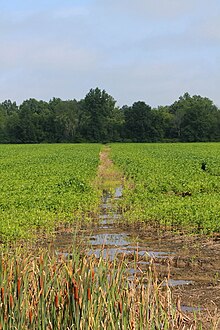
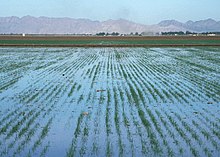
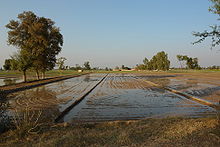


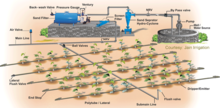

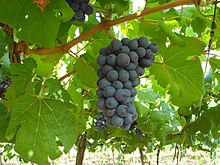

















0 maoni:
Post a Comment